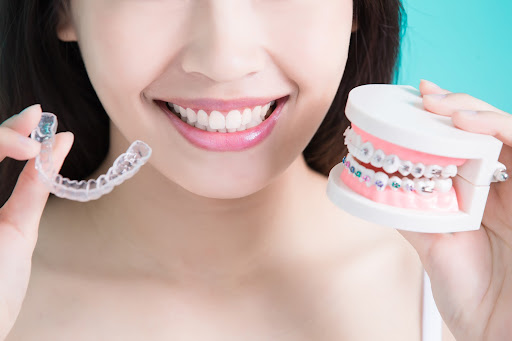Invisalign vs. Braces: Which is better?

Your smile is one of the first things people notice and remember about you. According to a publication published by the American Academy of Cosmetic Dentistry, nearly half the people surveyed consider smiles as the most memorable feature. Are you afraid that crooked or crowded teeth might be the only thing people remember about your smile? Then it’s time to consider orthodontic treatment.
Generally speaking, the two most popular teeth-straightening treatments are conventional braces and Invisalign clear aligners. Choosing between braces and Invisalign might seem like a daunting task, but never fear. Here, we discuss each option to determine the most suitable orthodontic treatment for your individualized case.
Function and Form
Braces and Invisalign both have the power to align the teeth with gentle force. However, braces use brackets attached to the front surface of the teeth and an archwire to shift the teeth into proper alignment slowly. An orthodontist makes frequent, minor adjustments to the braces to accomplish straighter teeth. Braces are made of metal, making them more noticeable when smiling, talking, or laughing.
As an alternative to metal mouth, Invisalign uses a series of clear trays to adjust the teeth gradually. The treatment plan consists of a series of tailor-made trays for each patient’s case based on contemporary, digital impressions for each patient’s case. With each set of fresh trays, the patient gets closer to a straighter smile. Unlike metal braces, Invisalign aligners are transparent and hardly noticeable. Therefore, clear aligners have a distinct advantage over braces regarding discretion.
Comfort and Minor Inconveniences
Regardless of which option you choose, the process of straightening the teeth can feel uncomfortable due to realignment. Normally, patients can manage the discomfort associated with orthodontic treatment with over-the-counter medication. However, other factors can contribute to the overall comfort of braces and clear aligner therapy.
An archwire is a metal wire that curves around the teeth and connects all brackets in traditional braces treatment. Unfortunately, if this wire snaps, it can poke and irritate the gums. When this happens, braces wearers are requested to:
- Step 1: Manage the inconvenience at home with orthodontic wax.
- Step 2: Visit their orthodontist as soon as possible.
Invisalign aligners are crafted of smooth plastic, so they are generally easier on the mouth’s soft tissue. Additionally, Invisalign applies less pressure to the teeth during periods of adjustment, and this means that patients won’t feel the same soreness as those with braces after an adjustment.
All things considered, people who choose clear aligner therapy and follow given precautions:
- May experience increased comfort
- Tend to require fewer in-person visits
Food Freedom and Removability
Compared to Invisalign users, patients with braces have added diet restrictions. People with braces must avoid hard and sticky foods to prevent the archwire from breaking and the brackets from detaching.
Because they are removable, Invisalign wearers can eat whatever they want, whenever they want. (As long as they brush between meals and wear their trays for at least 20 to 22 hours per day.)
Schedule an Invisalign Consultation in Salinas, CA
Are you ready to create a beautiful, healthy smile? Whether you choose braces or Invisalign, the first step is to schedule a consultation. Dr. Russell Cureton’s dental office is eager to help you start your journey to straight teeth. Call us at (831) 449-8363 or send us a message online to learn more about your orthodontic options.
